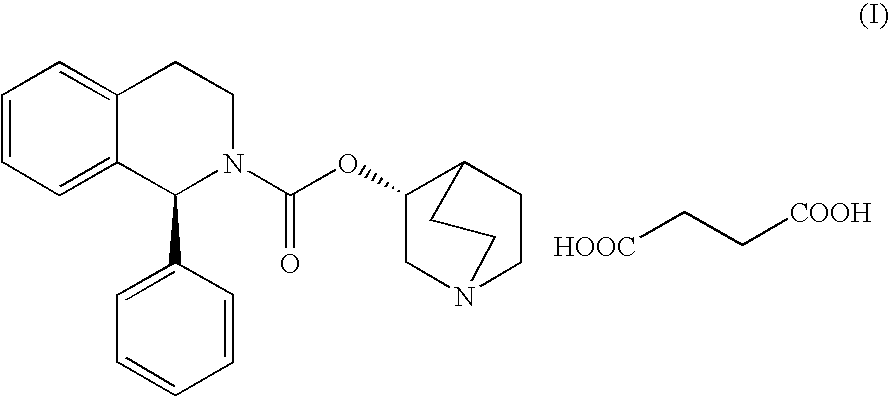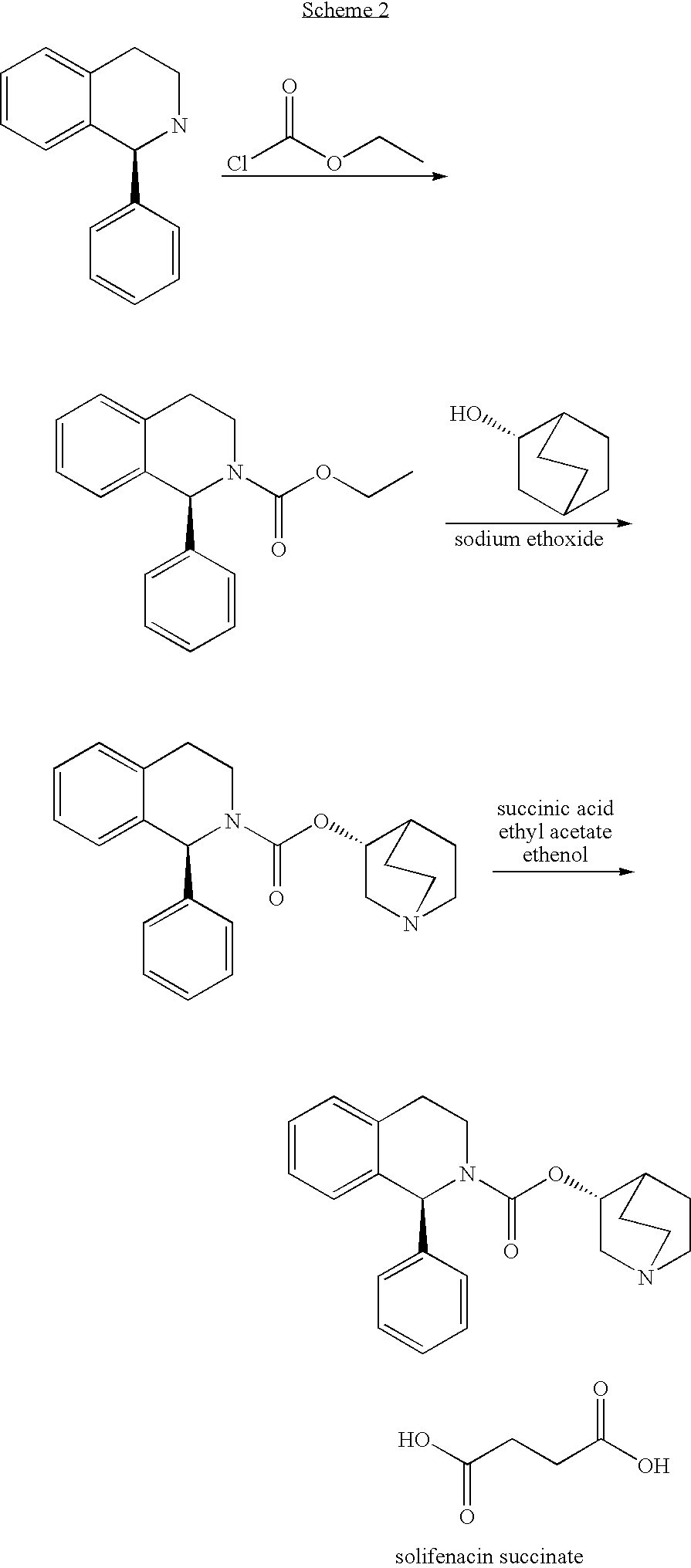Process for the Synthesis of Solifenacin
a technology of solifenacin and synthesis process, applied in the field of process for the synthesis of solifenacin, can solve the problems of laborious up process, significant toxicity, and process presents some drawbacks
- Summary
- Abstract
- Description
- Claims
- Application Information
AI Technical Summary
Benefits of technology
Problems solved by technology
Method used
Image
Examples
example 1
Preparation of (1S)-(3R)-1-azabicyclo[2.2.2]oct-3-yl-3,4-dihydro-1-phenyl-2(1H)-isoquinolinecarboxylate succinate (solifenacin succinate)
[0055]To a cooled solution of N,N′-carbonyldiimidazole (23.1 g, 142.5 mmol) in THF (156 mL), 25.0 g of (1S)-1-phenyl-1,2,3,4-tetrahydroisoquinoline (119.4 mmol) were added and the reaction mixture was stirred at room temperature for 2 h. This solution was finally diluted with 156 ml of THF.
[0056]To a mixture of (3R)-3-quinuclidinol (16.8 g, 132.1 mmol), sodium tert-amyloxide (14.6 g, 132.6 mmol) and aluminium chloride (1.1 g, 8.2 mmol), the previously prepared solution was added. The reaction mixture was stirred at reflux for 7 hours and then 150 mL of water were added to distil all the organic solvent. The residue was basified to pH>10 with an aqueous solution of NaOH 50% and stirred for 10-15 minutes. The resulting aqueous phase was extracted with EtOAc (2×130 mL) and the joined organic phases were washed with brine (2×100 mL).
[0057]Separately, 1...
example 2
Preparation of (1S)-(3R)-1-azabicyclo[2.2.2]oct-3-yl-3,4-dihydro-1-phenyl-2(1H)-isoquinolinecarboxylate succinate (solifenacin succinate)
[0060]To a cooled solution of N,N′-carbonyldiimidazole (4.62 g, 28.5 mmol) in THF (30 mL) was added the (1S)-1-phenyl-1,2,3,4-tetrahydroisoquinoline (5.0 g, 23.9 mmol). The reaction mixture was stirred at room temperature for 2 hours.
[0061]Then, aluminium chloride (0.21 g, 1.6 mmol) was added and the mixture was stirred at room temperature for 10 minutes. A suspension of (3R)-3-quinuclidinol (compound V, 3.8 g, 29.9 mmol) in tetrahydrofuran (30 mL) and sodium hydride 60% (1.20 g, 30.0 mmol) was added in portions. The reaction mixture was refluxed for 3 h, and then was filtered and concentrated in vacuo. The obtained crude was suspended in water (100 mL) and aqueous solution of NaOH 10% was added until pH>10. The resulting aqueous phase was extracted with EtOAc (2×50 mL). The organic phase was then dried with sodium sulfate, filtered and evaporated ...
example 3
Preparation of (2-(1H-imidazole-2-ylcarbonyl)-(1S)-1-phenyl-1,2,3,4-tetrahydroisoquinoline
[0063]To a cooled suspension of N,N′-carbonyldiimidazole (6.8 g, 41.9 mmol) in dichloromethane (50 mL) (1S)-1-phenyl-1,2,3,4-tetrahydroisoquinoline (8.0 g, 38.2 mmol) was added. Once the solids dissolved, giving a slightly yellowish clear solution, the mixture was stirred at room temperature for 2 h. The reaction was quenched with water (50 ml), the organic layer was washed with water (2×25 ml), dried over Na2SO4, filtered and concentrated in vacuo to yield the carbamoylimidazole derivative of formula IV, named (2-(1H-imidazole-2-ylcarbonyl)-(1S)-1-phenyl-1,2,3,4-tetrahydroisoquinoline (12.3 g, quantitative yield, 99.3% HPLC) as an oil.
PUM
 Login to View More
Login to View More Abstract
Description
Claims
Application Information
 Login to View More
Login to View More - R&D
- Intellectual Property
- Life Sciences
- Materials
- Tech Scout
- Unparalleled Data Quality
- Higher Quality Content
- 60% Fewer Hallucinations
Browse by: Latest US Patents, China's latest patents, Technical Efficacy Thesaurus, Application Domain, Technology Topic, Popular Technical Reports.
© 2025 PatSnap. All rights reserved.Legal|Privacy policy|Modern Slavery Act Transparency Statement|Sitemap|About US| Contact US: help@patsnap.com



